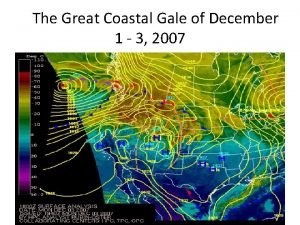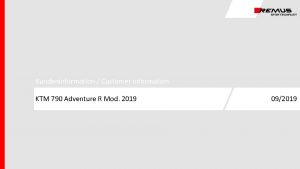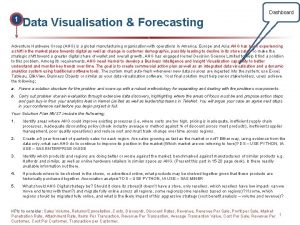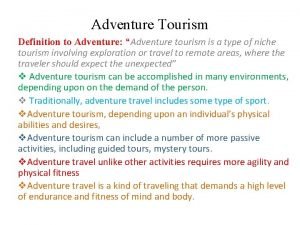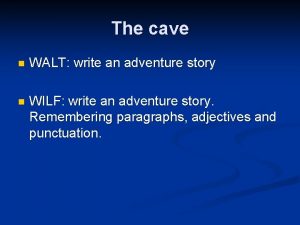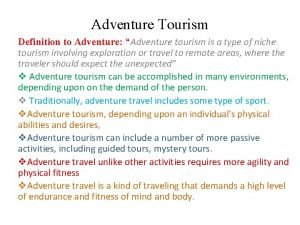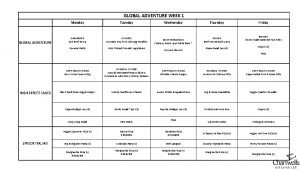Your Great Adventure Exploring Your Options Copyright 2007





































- Slides: 37

Your Great Adventure: Exploring Your Options Copyright © 2007 by Nelson, a division of Thomson Canada Limited. 1

Business Plan Building Block Chances are, you will Ø own your own business, or Ø work for a smaller firm (less than 100 people) “If you fail to plan……plan to fail” Copyright © 2007 by Nelson, a division of Thomson Canada Limited. 2

Canada is an Entrepreneurial Hot Bed • Women are leading the entrepreneurial charge. • “Seniorpreneurs” (those 55+) are one of the fastest growing small business segments. • Most of our self-employed (60%) have a post-secondary education. Chapter 1 Copyright © 2007 by Nelson, a division of Thomson Canada Limited. 3

Canada is an Entrepreneurial Hot Bed • About one third of our small business owners are serial entrepreneurs—they own or have owned more than one business. • 40% of Canadians think being your own boss is the most rewarding career decision. • 80% of all entrepreneurs say that starting a business was their best career decision Chapter 1 Copyright © 2007 by Nelson, a division of Thomson Canada Limited. 4

Small Business The Numbers • 2. 5 million Canadians are self-employed • The vast majority of employer businesses (98%) have fewer than 100 employees. • Most employer business (57%) have only 1 to 4 employees—the so-called micro businesses. Chapter 1 Copyright © 2007 by Nelson, a division of Thomson Canada Limited. 5

Small Business The Numbers • About 75% of small business employees work in the service sector. • Almost one-half of our labour force work for small enterprises. • Small businesses accounts for about 25% of our Gross Domestic Product—a key measure of economic production. Chapter 1 Copyright © 2007 by Nelson, a division of Thomson Canada Limited. 6

Business Establishments by Sector and Firm Size Number of Business Establishments Number of Employees Chapter 1 Total Goods. Producing Sector Service. Producing Sector 1 -4 589, 777 146, 065 443, 712 5 -9 180, 345 35, 551 144, 794 10 -19 125, 561 24, 483 101, 078 Copyright © 2007 by Nelson, a division of Thomson Canada Limited. 7

Small Business Entrepreneurs Are. . . • • Chapter 1 The fuel of our private enterprise system. Visionary self-starters who love the adventure of a new enterprise. Agents of change with POP. They are Passionate, Opportunistic and Persistent Doers, who see a market need and satisfy that need by translating it into a successful business. Copyright © 2007 by Nelson, a division of Thomson Canada Limited. 8

Successful Entrepreneurs Are… • • • Chapter 1 Passionate Opportunistic Persistent Visionaries Goal-oriented (results) Independent thinkers Idea generators People-oriented (service) Sharing Doers Moderate risk-takers Copyright © 2007 by Nelson, a division of Thomson Canada Limited. 9

Rev Up We encourage you to: • Assess your interests and abilities • (Action Step 3 & Action Step 4) Chapter 1 Copyright © 2007 by Nelson, a division of Thomson Canada Limited. 10

Idea Generator Mind Mapping • A mind map is an idea-generating sketch that features circled words connected by lines to form units • Mind mapping is a form of doodling— to generate ideas. • Sample on page 13 Figure 1. 2 • Sample on Page 44 Figure 2. 5 Chapter 1 Copyright © 2007 by Nelson, a division of Thomson Canada Limited. 11

Idea Generator Mind Mapping Mind mapping works like this: 1. Write down your vision and goals (what do you want your business to be) in the centre of a page and draw a circle around the key words. 2. Every time you get an idea related to this vision or theme, write it down, circle it, and draw a line connecting it to theme. 3. Keep adding new ideas to your mind map. Before you know it, you have a gigantic spider web or idea-tree full of opportunities (see Figure 1. 5). Chapter 1 Copyright © 2007 by Nelson, a division of Thomson Canada Limited. 12

Inc. Yourself • What does success mean to you? • Think of yourself as a product you want to create. • Create your own mind map—one that depicts the life you want (Personal Goals). • Discover what success means to you. (Action Step 5) Chapter 1 Copyright © 2007 by Nelson, a division of Thomson Canada Limited. 13

What is Small Business? ▪ A firm that is independently owned and operated and is not dominant in its field of endeavour. ▪ Any venture with spirit, any business you want to start, or any idea you want to bring into the marketplace. ▪ A small business would normally employ anywhere from 1 to 20 employees—about 85 percent of all businesses in Canada today. Canadian Federation of Independent Business Chapter 1 Copyright © 2007 by Nelson, a division of Thomson Canada Limited. 14

Your Chances of Success • Some small businesses fail—just like some students fail a course. • Failure is a part of life. • Slightly more than 80 percent of small businesses survive their first year. • On average, a company will be in business about 6 years. • Only about 30 per cent make it for ten years. • A business plan and research will help you beat the odds. Chapter 1 Copyright © 2007 by Nelson, a division of Thomson Canada Limited. 15

Three Main Research Approaches Market Research Collection and analysis of data pertinent to an existing or potential market Chapter 1 1. Primary Research Involves interacting with the world through interviews, observation, etc. (Action Step 6) 2. “New-Eyes” Research Involves the use of intuition and observation to learn things about the marketplace. (Action Step 7) 3. “Secondary Research Involves referring to someone else’s primary research. (Action Step 8) Copyright © 2007 by Nelson, a division of Thomson Canada Limited. 16

The Business Environment In a Business the Environment (external and internal) is the key source of information gathering – it’s critical to making good decisions and creating successful marketing plans. Economic Conditions The Internal Environment Natural Environment Socio-cultural Environment Business Plan Customers Political-legal climate Technology Competition Environmental Scanning: Process by which the marketing manager gathers and sorts information about the marketing environment. Chapter 1 Copyright © 2007 by Nelson, a division of Thomson Canada Limited. 17

Information Hunting Grounds ØNewspapers, Banks, Planning Offices ØPeople you know ØThe Internet ØIndustry Directories and Databases ØGovernment Records – Stats Canada (census data) ØGeneral Industry Data ü Actual and Potential market Size ü Market Growth Rates ü Market Profitability ü Industry Costs ü Distribution Costs Chapter 1 Copyright © 2007 by Nelson, a division of Thomson Canada Limited. 18

Checklist and Actions to Develop Your Business Plan q Are you organized? Do you have a central deposit for all you ideas? q Do you have what it takes to be an entrepreneur? q Have you assessed your interests, abilities, and weaknesses as they relate to owning a business? q Have you assessed your past accomplishments and shortcomings? q Do you have a list and a plan of new skills you will have to work on? q Is your family or those you live with “on board”? q Are you prepared to take the time and do the research to write a business plan? q Have you interviewed entrepreneurs to see what it is really like to be in business for yourself? q Do you have any business ideas which you are passionate about? Copyright © 2007 by Nelson, a division of Thomson Canada Limited. 19

Recognizing Opportunities Chapter 1 u Welcome to the entrepreneurial age § A new craft economy distinguished by quality, small customized quantities, technology, and service. § Where change creates opportunities for fast, flexible, and focused firms. u To be successful you will need to conduct market research and constantly respond to the changing needs of the marketplace. u The best business ventures to pursue are those which: • You enjoy • Make use of your unique experiences, skills and aptitudes • Serve a market need Copyright © 2007 by Nelson, a division of Thomson Canada Limited. 20

Idea Generator—Brainstorming is: · A free and open exchange of ideas. · A powerful technique used to help identify market trends and opportunities. · Used by many entrepreneurs who often record their brainstorming ideas using mind maps. · Successful when generated through an open, non-threatening environment that stimulates the creative juices. Chapter 1 Copyright © 2007 by Nelson, a division of Thomson Canada Limited. 21

Market Segmentation • Market segmentation involves: Ø Breaking down potential markets into as many similar sub-segments as possible (do a mind map). Ø Identifying opportunity gaps and seeing combinations of gaps that may constitute markets. (Action Step 14 but use “Boomers” in the group) Ø A good example is shown in the mind map in Figure 2. 5. – “In-Home Health Care” as one segment of the Health Care Industry Chapter 1 Copyright © 2007 by Nelson, a division of Thomson Canada Limited. 22

Trends Create Opportunity • Page 38 -40 • Change creates market trends that leads to Opportunity (Action Step 11, 12) • Look at the opportunities created by the “Boomers” and seniors in today’s society Chapter 1 Copyright © 2007 by Nelson, a division of Thomson Canada Limited. 23

Develop Your Pitch Begin to formulate your elevator pitch. Ø What is the market? Ø How does your business satisfy this market need? Ø How do you, the business and the target market benefit from this venture? Chapter 1 Copyright © 2007 by Nelson, a division of Thomson Canada Limited. 24

Checklist and Actions to Develop Your Business Plan q What trends will influence your small business idea? q What business are you really in? q What segment of the market will be your niche? q What gaps will you fill within that segment? q Is it a growth segment in a growth market? q Initially define your target market and determine how large that customer base is. q Identify the secondary sources you will use as part of your market research. q Does this business fit your vision and values? q Other than making money, what are the goals of your proposed venture? (You should be able to establish four to six over the next three years. ) q For your business, what objectives do you wish to achieve in the next year? Chapter 1 Copyright © 2007 by Nelson, a division of Thomson Canada Limited. 25

Culture and Values Culture ØA company culture and employee behaviour are a reflection of the owner’s personality and values. Chapter 1 Copyright © 2007 by Nelson, a division of Thomson Canada Limited. 26

Culture and Values Ø the things in life that are important to you Ø serve as guideposts for your actions Ø once crystallized, become the basis for your mission statement and goals The Bottom Line Your business must embody your values. Chapter 1 Copyright © 2007 by Nelson, a division of Thomson Canada Limited. 27

It’s All Connected Your Vision (mine not theirs) is based on Your Values and Beliefs. It is spelled out in Your Mission Statement, fleshed out in Your Goals and Objectives and accomplished through Your Strategy. Chapter 1 Copyright © 2007 by Nelson, a division of Thomson Canada Limited. 28

Success Chapter 1 Copyright © 2007 by Nelson, a division of Thomson Canada Limited. 29

Selecting the Right Opportunity 1. Identify your Personal Goals for your business. 2. Learn more about your favourite industry. 3. Identify promising industry segments. 4. Identify problems that need solutions. 5. Brainstorm for solutions. 6. Mesh possible solutions with opportunities in the marketplace—using a matrix grid. 7. Take stock and focus on the most promising opportunity – Opportunity Selection Filter pg 59 Chapter 1 Copyright © 2007 by Nelson, a division of Thomson Canada Limited. 30

Taking Stock—The Final Step • What is your industry? • What is your market gap? • What are your opportunities? Chapter 1 Copyright © 2007 by Nelson, a division of Thomson Canada Limited. 31

Chapter 1 Copyright © 2007 by Nelson, a division of Thomson Canada Limited. 32

Filling The Market Gap Market Industry Today The Path Industry Segment and Problems that Need Solutions Chapter 1 Your Business Plan “A good business plan is a Road Map to success” Copyright © 2007 by Nelson, a division of Thomson Canada Limited. Future Your Business Solutions for the Market 33

Customer Analysis Plays a key role in developing marketing strategy. The answers to the questions marketers should ask about their customers lead to a consideration of segmentation and a positioning analysis. – Who are the actual and potential customers? – Why do they buy our product (what value/benefit is attractive)? – Why do non-customers not buy our product? – Where do our customers buy our product? – How do they buy it (what is the decision making process)? – When do they buy it (what triggers the desire to purchase)? – What do they do with our product (how is it used)? Chapter 1 Copyright © 2007 by Nelson, a division of Thomson Canada Limited. 34

Competitive Analysis A major objective of business planning is to develop a sustainable competitive advantage. • Involves answering five questions: – Who are our competitors? What are their strengths and weaknesses? (Both direct and indirect) – What is our competitors’ strategy? To have advantage, our business strategy must be equal or ideally better than competition. – Should we compete? The answer should be based on resources/objectives of the firm, and expected profit potential. – If so, in what markets should we compete? Resources must be allocated to the areas of greatest opportunities. – How should we compete? Forces a focus on tactical decisions. Chapter 1 Copyright © 2007 by Nelson, a division of Thomson Canada Limited. 35

Test Your Business Idea Test your business idea by exploring these four themes. 1. Personal considerations. Does your business idea satisfy your personal goals and objectives? 2. Marketing considerations. Is there a market need for your product or service? 3. Production considerations. Will you be able to produce the required volume and quality of products and services? 4. Financial considerations. Can your operation satisfy the required financial goals? Chapter 1 Copyright © 2007 by Nelson, a division of Thomson Canada Limited. 36

Plotting Your Future Checklist q How is your product or service addressing the needs of the target market and offering benefits? q What are your business and personal values? q Define your market niche. q Define the idea filters. Chapter 1 Copyright © 2007 by Nelson, a division of Thomson Canada Limited. 37
 Copyright 2007
Copyright 2007 Pearson
Pearson Choose your own adventure java
Choose your own adventure java Your adventure begins
Your adventure begins Great is thy faithfulness o lord my father
Great is thy faithfulness o lord my father Great coastal gale of 2007
Great coastal gale of 2007 Phasels wood
Phasels wood Reading comprehension the adventure begins answers
Reading comprehension the adventure begins answers Features of a adventure story
Features of a adventure story Finding nemo journey
Finding nemo journey Perseus call to adventure
Perseus call to adventure Adventure education definition
Adventure education definition Lockerbie manor
Lockerbie manor Remus ktm 790 adventure
Remus ktm 790 adventure Mulan hero's journey
Mulan hero's journey Hercules call to adventure
Hercules call to adventure Adventure hardware
Adventure hardware The magic key youtube
The magic key youtube Sunny's adventure 2009
Sunny's adventure 2009 Adventure travel definition
Adventure travel definition Rock climbing rock climbing
Rock climbing rock climbing How to make a point and click adventure game
How to make a point and click adventure game Fuller center bike adventure
Fuller center bike adventure Paragraph about an adventure story
Paragraph about an adventure story Sectors of tourism industry
Sectors of tourism industry Desert island adventure
Desert island adventure Sonic rush adventure review
Sonic rush adventure review Minion adventure
Minion adventure A sticky adventure! ?✨
A sticky adventure! ?✨ Adventure high walkthrough
Adventure high walkthrough Adventure tourism essay
Adventure tourism essay What is an open thesis statement
What is an open thesis statement Word formation continue
Word formation continue Spider man 2002 hero's journey
Spider man 2002 hero's journey Northstar dibba camp
Northstar dibba camp Adventure adjective
Adventure adjective Rob hall adventure consultants
Rob hall adventure consultants What is the abyss or temptation
What is the abyss or temptation





